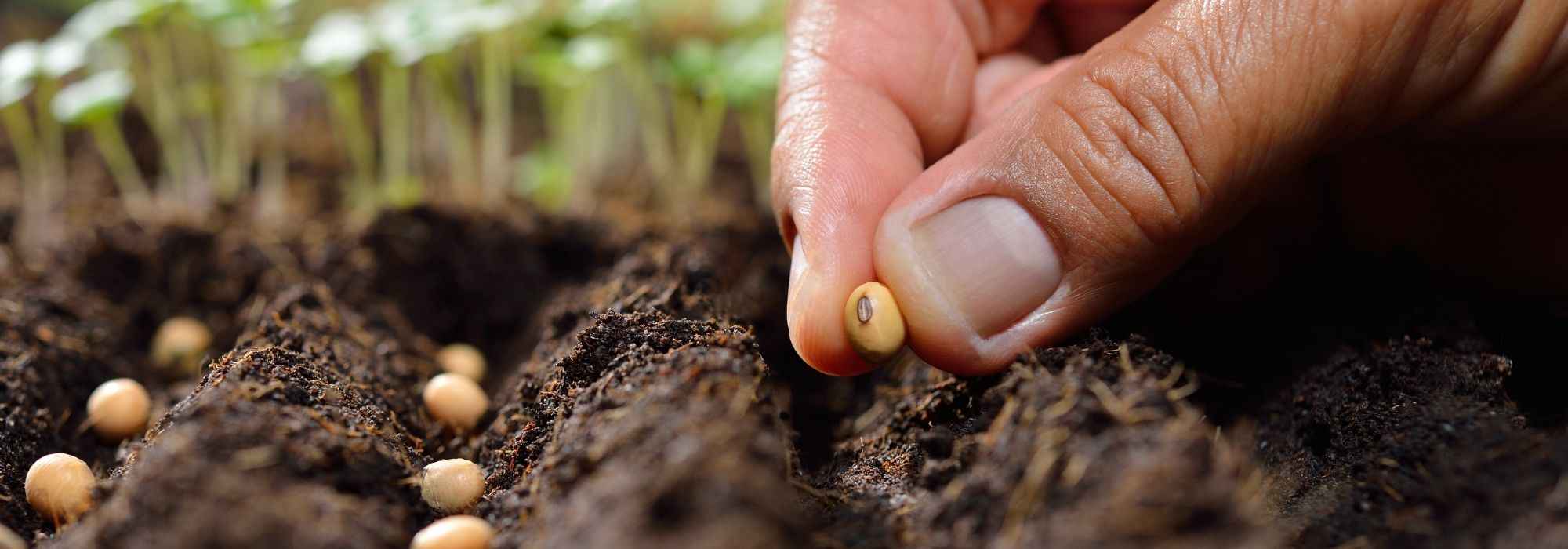
5 Ways to Multiply Your Plants for Free
All you need to know about the different propagation techniques, their advantages and disadvantages.
Contents
Plants multiply freely and almost effortlessly in the garden, whether spontaneously or through the gardener’s intervention. Propagation by cuttings, layering, division, sowing, or even grafting are all possibilities for obtaining new plants.
Let’s take stock of these different techniques of vegetative propagation. Together, we will explore the advantages and disadvantages of each technique, allowing you to choose the one best suited for each of your plants.
Whatever method you choose, we advise you to always use well-sharpened and previously disinfected tools to avoid any transmission of diseases between your plants.
Propagation by cuttings
Propagation by cuttings is a method of multiplication that allows you to obtain faithful clones of a plant subject from one of its fragments.
For this, we use a part of what is called the mother plant (stem, leaf, root), which will grow autonomously, recreating a complete plant with aerial parts and a root system. The new plant will retain all the characteristics of the parent plant: colour, shape, etc.
Propagation by cuttings allows you to multiply an existing variety almost infinitely, for example, to create a hedge. It also allows for the renewal of aging subjects that tend to lose their aesthetic qualities or become less productive.
We distinguish between stem cuttings (herbaceous, semi-woody, from hardwood), leaf cuttings, and, more rarely, root cuttings. Each cutting is performed at a different time of year, depending on the segment and the plant species involved.
To succeed with your cuttings, always choose healthy, vigorous plant pieces that are free from diseases. If they bear fruits, flowers, or buds, remove them so that the cutting can focus on root formation. This also helps limit natural evaporation through the aerial parts.
To maximise your chances of success, you can also use rooting hormone, which facilitates rooting and speeds up the healing of the cutting.
Once cut, the cutting can be cultivated in the ground, in a pot with a light, well-drained substrate, or simply in a container of water. Propagation in a humid environment often presents the best chances of success. For this, simply use a bottle or plastic bag positioned around the cutting planted in the soil to recreate favourable conditions of warmth and humidity, like in a mini-greenhouse.
For further reading, check our advice sheets “Propagation by cuttings: everything you need to know about different techniques and our advice” and “What is a root cutting?”.
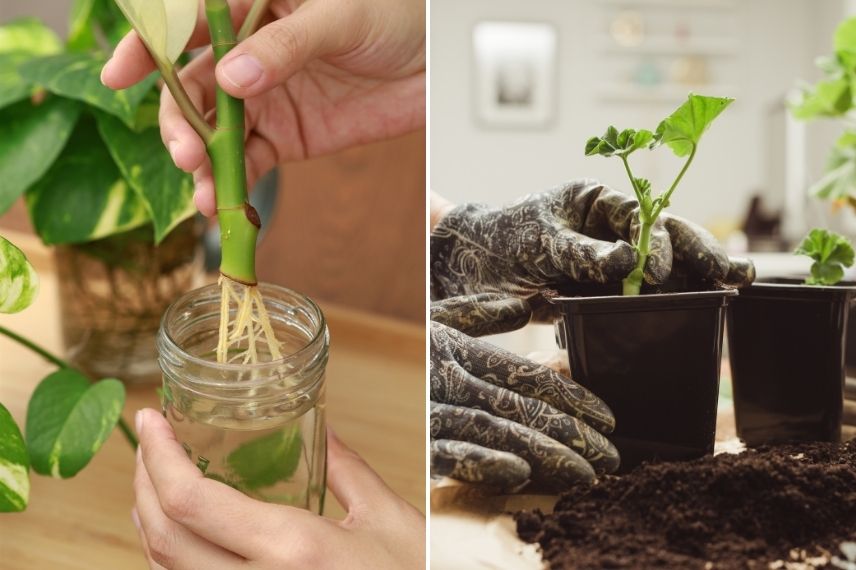
Cutting technique in water or cutting in a substrate
Advantages and Disadvantages
Pros
- Simple to carry out, even for beginner gardeners
- Fairly high chances of success
- Faithfully reproduces the genetic characteristics of the mother plant
- Suitable for the multiplication of many plant species
- Possible to obtain several new plants from a single plant
Cons
- Requires having a mother plant available
- A minimum of care and monitoring is necessary to succeed with propagation
Plants Suitable for Propagation by Cuttings
Many species of plants can be propagated by cuttings:
- perennials, such as heather, sedum, agastache, sage, heuchera, lavender, …
- climbers, such as passionflower, ivy, honeysuckle, hops, …
- bushes, such as oleander, hydrangea, mock orange, abutilon, deutzia, …
- small fruit plants like raspberries, …
- houseplants, such as pothos, succulents, wandering jew, sansevieria…
For further reading:
Layering
Layering is a technique that involves initiating root development on a plant stem. Layering can sometimes occur spontaneously in nature when a plant’s stem touches the ground for an extended period. Once the roots have developed, the new plant will be weaned, meaning it will be detached from the parent plant.
As with propagation by cuttings, we obtain therefore a perfect clone of the initial plant.
Layering can be done by soil layering (for plants with long, flexible stems), air layering (for plants whose stems are difficult to bend without breaking), serpentine layering (for plants with very flexible stems that allow for bridging), or hilling (for coppiced bushes). Each method depends on the type of plant being layered. The suitable period also varies according to the technique used.
Always choose a healthy, vigorous stem, taking care to remove the leaves so that the plant can focus on developing its root system.
Once the roots have developed, after a few months, use a cutting tool to separate the new plant from the parent plant. It can then be replanted either in a pot or directly in the ground.
For further information, check our advice sheet “Layering: how to do it?”.

On the left, layering of a plum tree (photo solylunafamilia-Flickr); on the right, the principle of layering
Advantages and Disadvantages
Pros
- Simple to carry out, even for beginner gardeners
- Very high success rates, as the plant develops its roots while still being nourished by sap from the parent plant
- Faithfully reproduces the genetic characteristics of the mother plant
- Allows for the multiplication of plants that are poorly suited to propagation by cuttings
- Suitable for multiplying many species of plants
- Possible to obtain several new plants from one plant
- Requires little equipment
- Needs minimal attention and care
Cons
- Requires having a parent plant available
Plants Suitable for Layering
Layering is particularly suitable for woody plants with flexible stems. However, air layering or hilling techniques also allow for layering of species with stiffer stems. You can easily layer:
- perennials, such as heather, thyme, …
- ornamental shrubs, such as lilac, viburnums, daphne, hibiscus, …
- fruit trees, such as fig, Japanese quince, currant, …
- climbing plants, such as clematis, wisteria, Virginia creeper, climbing rose, …
- indoor plants, such as ficus, dracaena, rubber plant,…
For further reading:
The division
Division allows for the renewal of a perennial plant’s stump that tends, as it ages, to become bare, spread too much, or slow down growth and flowering. The divided plant can thus regenerate and gain space.
Division involves separating the root system clump of a plant into two or more parts, in order to obtain several identical new fragments. Once divided, the stumps can be replanted in the ground or in pots.
Division is carried out on well-established plants (several years of cultivation), during the dormancy period, usually at the very beginning of spring or at the end of autumn.
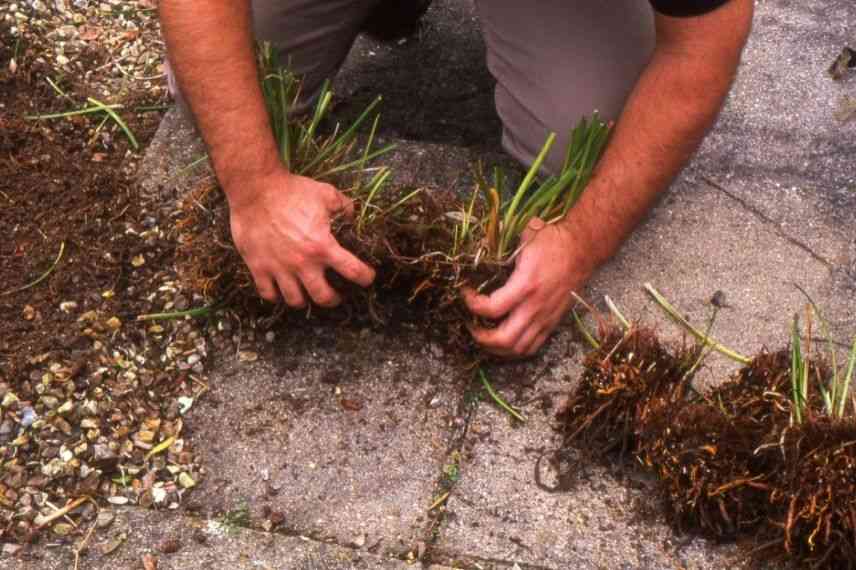
Stump division
Advantages and Disadvantages
Pros:
- the fastest multiplication method
- easy to perform, even for beginner gardeners
- very high success rates, as the plant already has a root system
- faithfully reproduces the genetic characteristics of the mother plant
- maintains and stimulates an aging mother plant
- allows for the rapid reproduction of several new plants
Cons:
- Requires having a mother plant available
- Can only be done after a few years of cultivation
Plants Suitable for Division
Clump-forming or fleshy-rooted perennial plants are particularly suited for multiplication by division. This includes, for example:
- flowering perennials, such as water lilies, hardy geraniums, daylilies, asters, …
- grasses, such as carex, molinia, panicum, …
- bulbous or rhizomatous plants, such as bamboos, iris, agapanthus, dahlias, chives, …
- indoor plants, such as calathea, maranta, …
Read also
Thinning of sowingsSowing
As with layering, the propagation of a plant by sowing occurs spontaneously in nature or in the garden. For a gardener, watching a plant grow from seed to ripening is undoubtedly one of the most satisfying experiences!
Sowing can be done either by collecting seeds from a plant or by purchasing them online, at garden centres, or specialist shops. You can choose them in various packaging, such as packets or strips, for example. If you wish to collect your own seeds later, be sure to select varieties with reproducible seeds (non-F1).
Sowing is less reliable than other propagation methods, as it does not guarantee that you will obtain exactly the same variety of plants. The success rate varies depending on the species involved and requires specific conditions for proper germination. Issues such as damping off or leggy seedlings may occur.
For indoor sowing, this method also requires a minimum of equipment: pots or trays, suitable potting mix, spray bottle, labels, and possibly a mini-greenhouse, etc.
Several steps will be necessary throughout the growth of your seedlings: thinning, repotting, various care, etc. By selecting the best-developed subjects in advance, you ensure that you will have robust and durable new plants.
There are many different methods for sowing: in trays or pots, broadcasting, in clusters, in rows… They mainly depend on the type of plants involved and your garden.
We advise you to strictly adhere to the sowing periods according to the plants and their natural cycle. However, sowing can be hastened if you have a sheltered, frost-free, or even heated place, such as a greenhouse or conservatory.
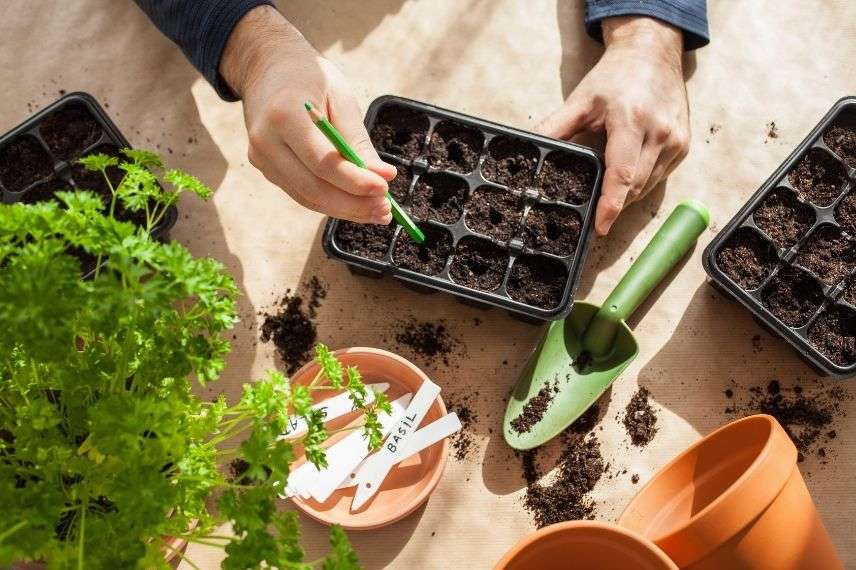
Seed sowing
For further information, check out our numerous advice sheets dedicated to:
- “Sowing in pots”
- “Sowing in trays”
- “Sowing in rows”
- “Sowing in clusters”
- “How to successfully sow by broadcasting?”
- “How to sow on an alveolate tray?”
- “How to sow seeds on seed tape?”
- “Sowing seeds directly in the ground”
- “Sowing in warmth or on a hotbed”
- “Sowing annual seeds: how to do it well, in the ground or in trays?”
Advantages and Disadvantages
Pros
- The best way to propagate annual plants
- Relatively simple to do
- Cost-effective technique
- Rewarding and fun, as it allows you to observe the complete cycle of a plant
- Enables you to obtain a large quantity of plants, ideal for quickly creating borders, pots, rockeries, etc.
- Produces new strong, vigorous, and adaptable plants
Cons
- Less reliable, as it may lead to hybridization or cross-breeding
- Success rate depends on several factors
- Requires some equipment
- Needs patience, observation, and care
Plants Suitable for Sowing
Annual plants are the most suitable for propagation by sowing, but biennials, perennials, and even some bushes are also good candidates:
- flowers, such as sunflowers, cosmos, marigolds, sweet peas, …
- vegetables, such as tomatoes, cucumbers, squashes, radishes, …
- herbs, such as basil, parsley, coriander, …
- perennials, such as delphiniums, foxgloves, lupins, …
- shrubs, such as buddleia, weigela, hibiscus, …
- but also trees, such as oak, birch, plum, yew, …
For further reading:
- “10 easy trees to sow”
- “10 easy shrubs to sow”
- “10 easy annual flowers to sow”
- “10 very easy perennials to sow”
- “Kitchen garden: 7 easy vegetables to sow in early summer”
Grafting
Grafting allows for the faithful multiplication of a horticultural variety or the combination of the qualities of two varieties.
For this, we use a rootstock selected for various qualities (disease resistance, natural vigour, tolerance to a specific climate or soil type), which will provide the root system. On this rootstock, a scion prized for its ornamental or taste qualities (flowers, fruits, leaves) is implanted and then fused, which will form the aerial parts.
To graft a plant, a shoot or a bud from the scion is directly implanted into the tissues of the rootstock. This method is one of the most technical for multiplying a plant.
Grafting also allows for the creation of varieties that do not exist naturally, such as stem or weeping roses.
There are several grafting techniques, varying according to the species to be reproduced: shield or bud grafting (stone fruits), cleft grafting (pome fruits), crown grafting (to rejuvenate an old variety), approach grafting, English grafting (more complicated to perform), etc.
Grafting is carried out with a specific tool, which must be of good quality: the grafting knife.
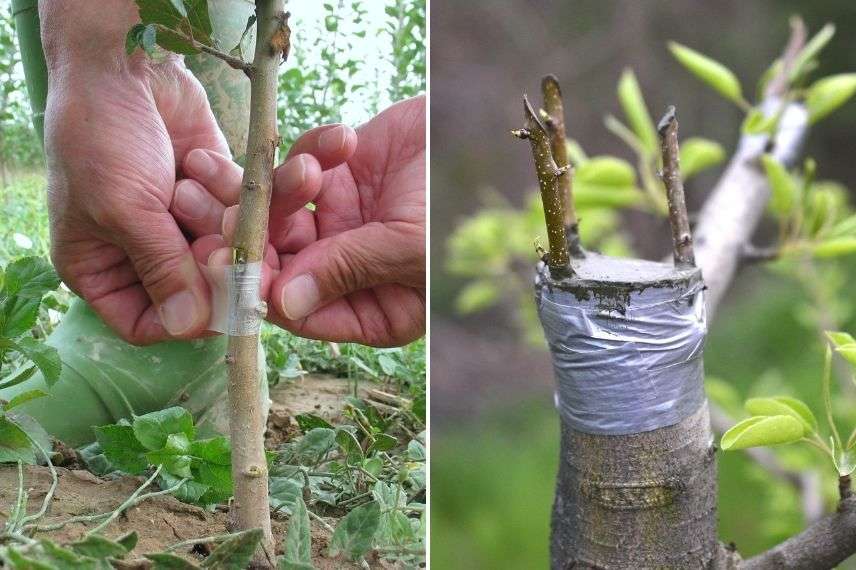
Shield grafting and crown grafting
For further reading, check our dedicated advice sheets:
- “Grafting Trees: Different Techniques”
- “What is a Rootstock and Which One Should You Choose?”
- “What is a Grafting Knife Used For?”
Advantages and Disadvantages
Pros
- Allows for the multiplication of plants that cannot be reliably and faithfully propagated by sowing or propagation by cuttings
- Results in a new robust, resistant, and productive plant, combining the genetic qualities of two varieties
Cons
- Technique is rather professional, requiring knowledge and experience
- Requires specialised equipment
- Grafted subjects may be fragile at the grafting point and have a shorter lifespan
Plants Suitable for Grafting
The plants generally grafted are:
- fruit trees, such as pear trees, plum trees, citrus trees, grapevines, …
- modern hybrid roses
- fruiting vegetables, such as tomatoes, peppers, aubergines, melons, …
For further reading:
- “Grafted Vegetable Young Plants”
- “Why are Fruit Trees Grafted?”
- “Why are Roses Grafted?”
- Subscribe!
- Contents
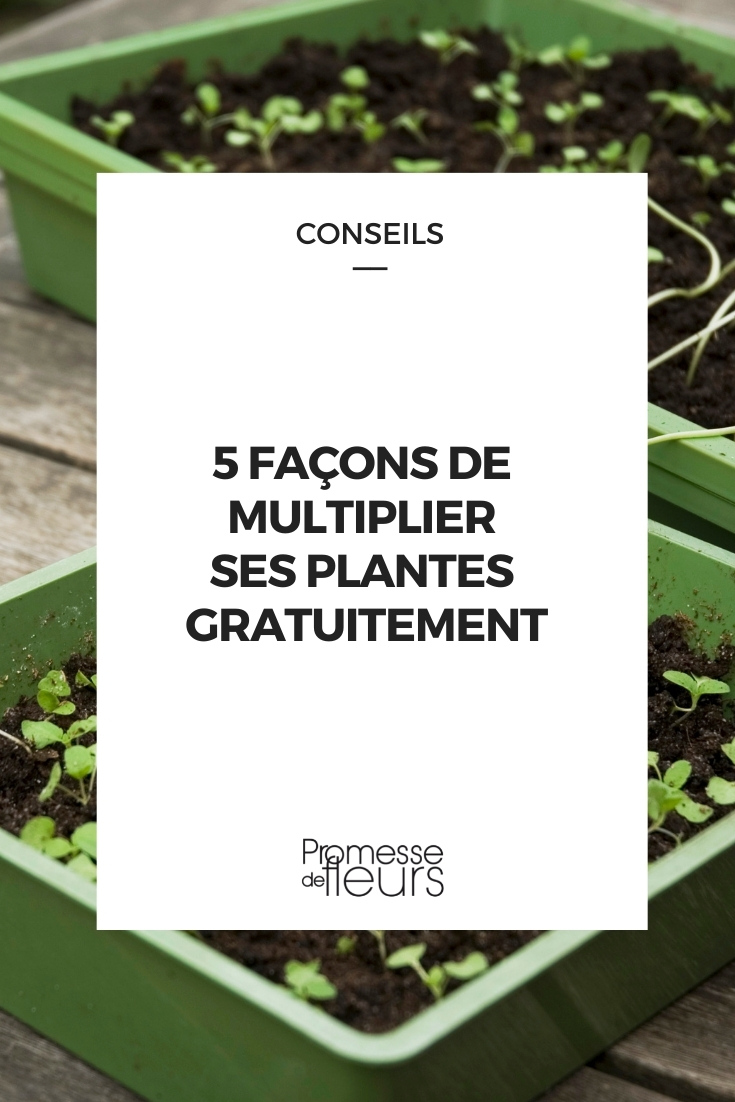































Comments